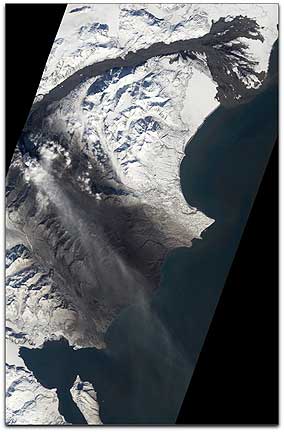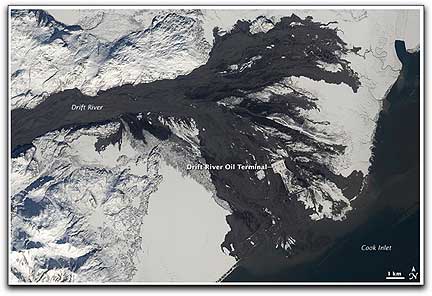 In addition to volcanic ash, the eruption of Alaska’s Mount Redoubt posed another hazard in early April 2009 — the volcano’s activity sent lahars (muddy volcanic avalanches) through Drift River Valley, according to the Alaska Volcano Observatory. An oil storage facility, the Drift River Oil Terminal, is located in the river valley, and a catastrophic lahar could have caused an oil spill.
In addition to volcanic ash, the eruption of Alaska’s Mount Redoubt posed another hazard in early April 2009 — the volcano’s activity sent lahars (muddy volcanic avalanches) through Drift River Valley, according to the Alaska Volcano Observatory. An oil storage facility, the Drift River Oil Terminal, is located in the river valley, and a catastrophic lahar could have caused an oil spill.

On April 4, 2009, the
Advanced Land Imager (
ALI) on
NASA’s
Earth Observing-1 satellite captured this image of the
Drift River Valley where it connects with
Cook Inlet. Lahars have stained the river valley a deep muddy brown. Water channels form branching patterns just west of the Cook Inlet shore, and the dark brown color of each water channel contrasts sharply with the nearby snow. The Drift River Oil Terminal resides in this network of channels, and part of the facility appears as an off-white rectangle in a landscape of meandering mudflows. The same day that ALI acquired this image, the
Alaska Volcano Observatory reported that a lahar had developed in the Drift River Valley, as indicated by seismometer readings. Lahars had also been recorded in the Drift River Valley during the previous weeks. On April 6, 2009, the tanker
Seabulk Arctic carried 3.7 million gallons of crude oil away from the Drift River Oil Terminal, reducing the risk of a massive oil spill. (On March 22, 2009, at the beginning of Mount Redoubt’s period of unrest, the facility contained 6.2 million gallons of oil.) A lahar struck the area on March 23, but a dike built in 1990 kept the facility’s oil tanks dry.
Topical Tags :
Regional Tags :